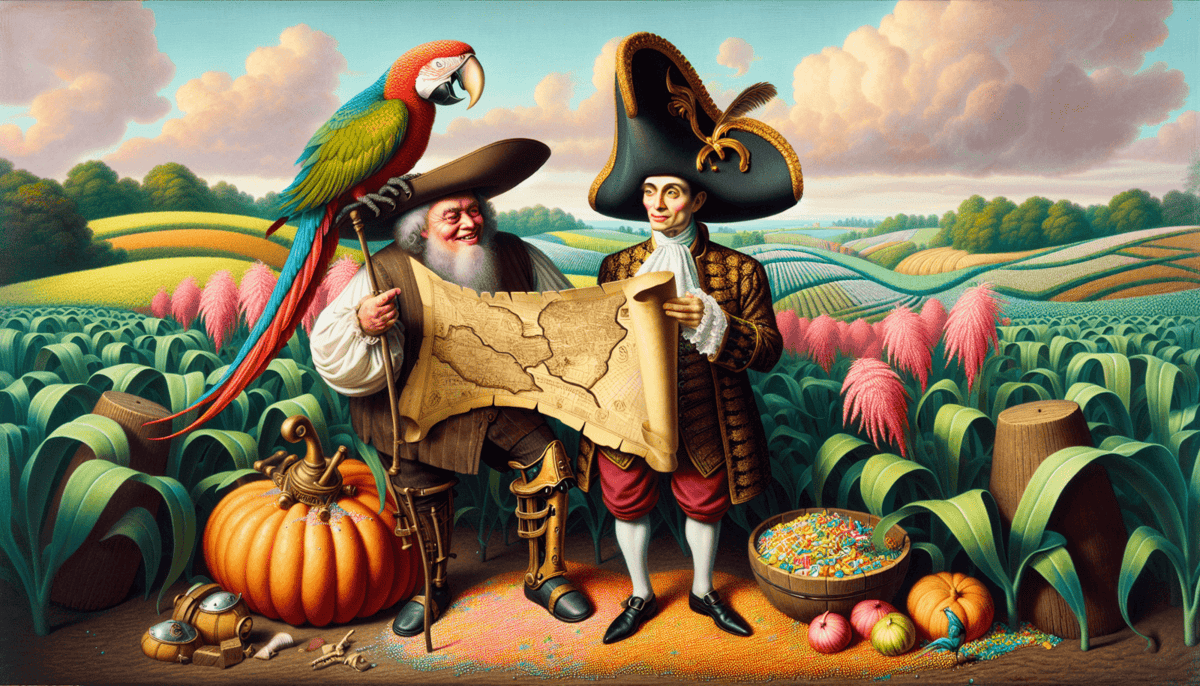Have you ever wondered how pirates managed to store food for their long voyages without going nuts from scurvy or food poisoning? I mean, these folks were swashbuckling between tropical storms and enemy attacks while also trying to keep their rum-soaked bread fresh. If that’s not a juggling act, I don’t know what is. So, what did our beloved pirates munch on while yelling “Yo-ho-ho” and plundering hefty treasures?

Unpacking the Treasure Chest: Pirate Diet 101
Let’s face it: romanticizing pirates like Johnny Depp has gotten us into thinking that pirate life was all about endless rum and glamorous sword fighting. But let’s break it down, shall we? Pirates faced one major challenge-food storage. And who knew keeping moldy bread edible could be such an art?
The Not-So-Palatable Pirate Menu
First off, let’s talk about the pirate menu that would make a five-star chef cringe. We’re talking hardtack, salted meat, dried beans, and, if they’re lucky, some dried fruits. Imagine living off this delightful spread for months. Forget gluten-free; it’s more like joy-free.
| Food Item | Description | Storage Method |
|---|---|---|
| Hardtack | Flour and water biscuits, rock-hard | Stored in barrels |
| Salted Meat | Beef or pork preserved with salt | Stored in barrels or casks |
| Dried Beans | Long-lasting dried beans | Stored in sacks |
| Dried Fruits | Fruits dehydrated for longevity | Stored in barrels or jars |
| Rum | Fermented sugarcane juice, the pirate elixir | Stored in barrels or bottles |
Hardtack: The Original Jawbreaker
Hardtack was like the fast food of pirate life-easy to make, transport, and it won’t spoil. But fair warning: it might break a tooth or two. Pirates used to soak hardtack in water or rum to make it chewable, turning their meal into a jaw-testing experience.
The Pickling Party: Preserving Meats Like a Pirate
Life isn’t a picnic when you’ve got salted meat that smells nastier than your unwashed pirate socks. Salted meat was a pirate’s lifesaver but also their biggest challenge. Who thought it was a good idea to carry around slabs of meat preserved in salt? Clearly, desperate times.
Salt: The Age-Old Magic Dust
Salt was the real MVP here. By curing meat in salt, pirates could fend off bacteria and mold. Still, a slab of salted beef carries all the charm of a cardboard sandwich. And let’s be honest, anyone complaining about their mom’s meatloaf clearly never had pirate meat.
The Tricky Business of Barrel Storage
Ah, the barrel! The less glamorous cousin of the treasure chest. Pirates relied on barrels more than they relied on their cutlasses. These barrels were used to store everything from food to fresh water to-you guessed it-rum. Captain Jack Sparrow we see you.
Water Woes: The Struggle for Fresh Water
Finding fresh water was harder than finding Waldo in a sea of stripes. Pirates stored water in barrels coated with tar to prevent leaks, but this only delayed the inevitable slime and algae growth. Thank goodness they had rum, right?
| Container Type | Usage | Storage Challenge |
|---|---|---|
| Barrels | Water, rum, salted meat, hardtack | Leakage, mold, slime |
| Sacks | Dried beans, grains | Moisture, rats |
| Glass Bottles | High-use liquids like oil or rum | Fragility, space-consuming |
The Daily Grind: Pirates vs. Nutrition
Pirates didn’t have the luxury of a nutritionist or keto diet, so they battled scurvy-a vitamin C deficiency-by trying to stock up on anything remotely healthy. Picture them gnawing on lemons and sour oranges like their lives depended on it-because they did.
Scurvy: The Mutiny Maker
Nothing says “epic sea adventure” like losing your teeth and developing sores. If the captain couldn’t get his hands on citrus fruits, mutiny was just around the corner. I bet no one discusses mutiny over a lack of kale smoothies these days.

The Fun Factor: Drinking More Than Just Rum
Now, what did pirates drink when water dwindled to algae soup? Good ol’ rum! It wasn’t just about getting merry; rum was safer to drink than water. Ever tried staying sober during a pirate raid? Didn’t think so.
Grog: The Pirate’s Cocktail
Grog wasn’t just another pirate slang word-it was a drink made of watered-down rum and sometimes lemon or lime juice to fend off scurvy. Imagine diluting your drink to make it healthier. These pirates were the original DIY mixologists.
Modern Takeaways: What Pirates Teach Us About Food Storage
Okay, real talk for a minute: what can we learn from these rum-guzzling, scurvy-fighting pirates? Turns out, a lot. Food storage might not involve battling sea monsters, but those techniques have evolved into practices we still use today.
Food Preservation: Then and Now
Salt curing, pickling, and drying are still popular methods of food preservation. Plus, climate-controlled storage might have been a game-changer for pirates. Forget your modern-day Netflix binge; pirates would kill for a refrigerator.
Storage Hacks: Borrowed from Pirates
Who knew that the ever-glamorous pirates were food wastage warriors? They nailed using limited resources efficiently. Next time you’re moaning about your meal prep, just remember: it could be hardtack.
Conclusion: Laughing Through History
Let’s give the pirates some credit for being the survival experts they were. Between battling enemies, weathering storms, and dodging scurvy, they managed to keep their bellies (somewhat) full. So, the next time you think you’ve got it tough, just imagine trying to chew through hardtack or gulp down algae water. Suddenly, your leftovers don’t seem so bad, do they?
And hey, if pirates could find humor in their salty, crumbly, and grotty meals, maybe we can laugh a bit about our own kitchen fiascos. Arrr, matey!








